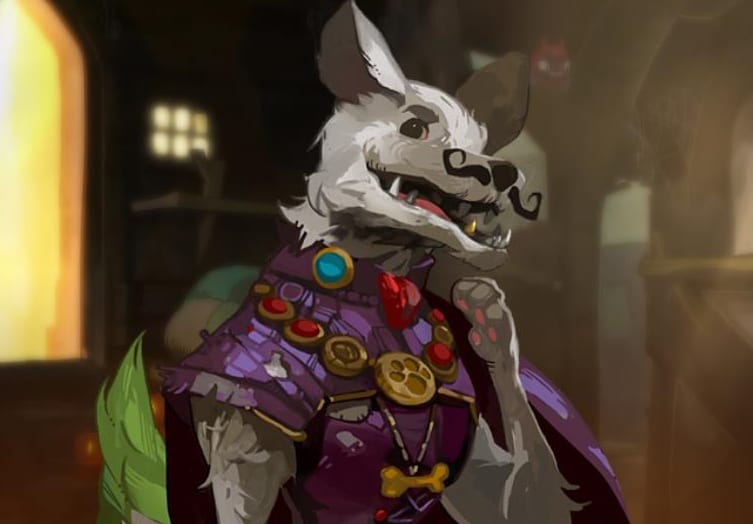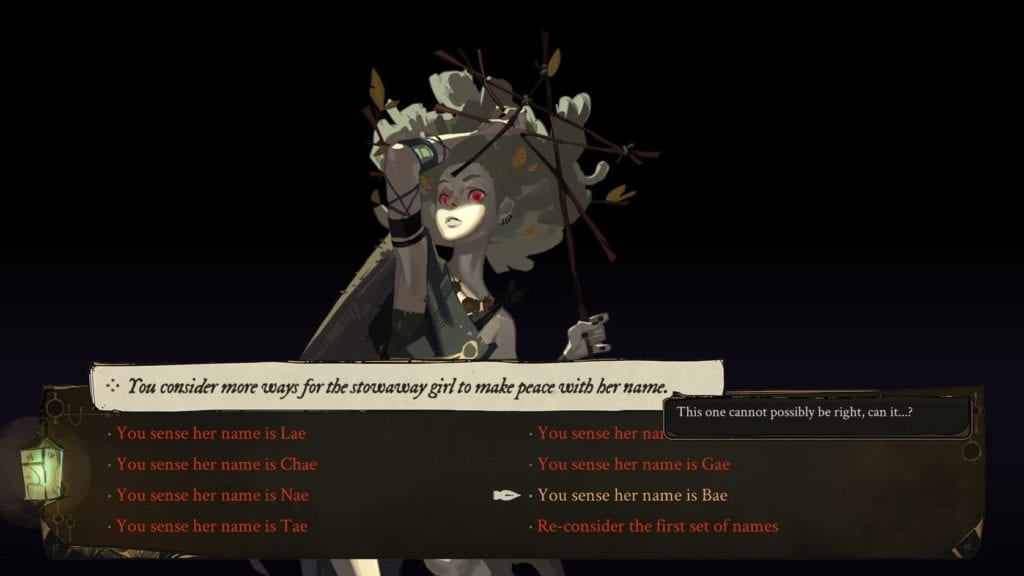Today dear readers, I’d like to discuss a video game that might have flown under a lot of people’s radar, but one I feel people should pay more attention too: Supergiant Games’ Pyre. Now there will be spoilers. I’ll talk around some of the bigger ones, but I won’t be able to talk around them all. If you’re interested in going into the game completely blind this is your warning to turn back now.
Ain’t no rule that basketball can’t be an RPG.
Pyre is a hard game to classify right off the bat, as it really doesn’t fit neatly into any genre. The best way to describe it is a visual novel/RPG/sports game.
…Wait, don’t run away! It’s better than it sounds!
How it actually works is this: 99% of the game’s dialogue and plot is in a visual novel style, with the player selecting their responses from a dialogue tree. (Pyre does something unique, that whenever you mouse over a highlighted word or phrase, it gives a short explanation of what that person, place, or thing is. It allows for quicker immersion and helps remind you what everything is if you haven’t played in a while). During the ‘sports’ section of the game, the gameplay switches to something similar to a 3 on 3 basketball game. The goal is to place the ‘celestial orb’ in your opponent’s pyre, and try to prevent them from doing the same. Since you can only control one character at a time this requires a bit of strategy and positioning.
Each character also has a different set of skills and abilities they can use to add to your strategy. Once you get the hang of the game though it is quite fun. As you play the characters they will level up, learning new skills. You can also buy accessories for them to shore up weaknesses, or to specialize them even further. This is where some of the RPG elements come into focus.
It’s not a nice place to visit, and I wouldn’t want to live there.
Still, the real strength of the game is how it manages to combine these disparate elements together into one whole, cohesive story. The basic plot of Pyre is that there is a tyrannical government, known as the Commonwealth. It used to stand for freedom and mutual respect, but now has become corrupt. When convicted of a crime, the ‘criminal’ is summarily exiled to the ‘Downside’, a harsh land that is a living purgatory, with no escape. The Downside is barely habitable, consisting mostly of poisonous swamps, deserts, vast oceans with storms that rage across them, and volcanic plains. Even if you manage to find an area that seems habitable, you have to deal with the fact that the vegetation is either all poisonous, or actively hostile towards you. In short, Downside is an awful place to live.
The player controls an unnamed hooded figure, known as ‘The Reader’, exiled to the Downside for the crime of literacy. In this world, being able to read is a felony. (And in a wonderful little bonus, you can play as a male, female or have the other characters ‘not presume your gender’ and use gender neutral language throughout the entire game.) The Reader would have died, if they weren’t rescued by a wagon carrying a group of three people wearing strange masks: Hedwyn, a personable human, Jodariel, a dour demon (in this game demons are humans who have remained in exile for a long time, their time in the Downside has changed them, causing them to grow horns), and Rukey Greentail, a talkative and loud cur (which is a semi-anthropomorphic dog) with an amazing mustache.

They nurse your character back to health, and explain that there is an escape from the Downside. By competing against other Triumvirates, you’ll be able to earn your freedom. However, they require someone who can read, as the ‘Book of Rites’ is the key to finding where these rituals take place. It’s here that Hedwyn makes a deal with you: help them succeed in the liberation rites, and they will help you go free. As you compete in the rites, you gain more party members. From the loyal and honorable Wyrm Knight Sir Gillman to the mischievous and teasing Harp Pamitha. My personal favorite character was The Stowaway; a slightly odd young woman whose name you choose from an extensive list, all of which end with -ae. (And yes, you can name her Bae). 
During your travels to the different ritual sites—both before the rite and after the rite—you will be able to talk to your party members and learn things about them. At first, they will be slightly hesitant to trust you but as you progress further they begin to trust you more and tell you about themselves. One of the things you could learn is what crime your companions committed. They were all exiled for a different reason, and each ‘crime’ they allegedly committed was nothing of the sort. Jodariel’s banishment was because she refused to execute a group of captured POWs. Rukey’s exile was for the crime of smuggling supplies into the Downside to earn extra money to help care for his ill mother.
In addition to conversations with the player, characters will have conversations among themselves occasionally. This is where you will learn that Jodariel was a warm and nurturing woman who adopted Hedwyn as a child when his parents died. In addition to learning more about your compatriots backstories, you can assist them in their personal storyline. One storyline involves helping the Stowaway make friends with a young man who is part of a different Triumvirate. Another involves speaking with Sir Gilman and helping him to reclaim his lost honor.
All of these different plot threads are incredibly well written and make it very easy to sympathize with these characters. You want to help them solve their problems, you want to help them escape from the Downside and return home. However, there is a trick to these conversations and quests. You can only progress along them by using that specific character in the rites. Sometimes, you need to be up against a specific opponent to unlock the next stage of the conversation. This adds a sense of realism to the world to me. After all, if you’re willing to trust them with helping earn their freedom, they can trust you with their history.
Never to Return…
(SPOILER ALERT. We will be discussing one of the bigger spoilers of the first part of the game here. This is the last warning.)
Once you reach the final rite (known fittingly as the Liberation Rite) you discover two things in short succession. First, your character is incapable of returning home. Only those that actively complete the rites are eligible. Meaning that your character, crippled since their exile, can never go free. Second, only one person may go free at a time. If you wish to free someone else, you will need to complete the rites all over again. This sends your party into a tizzy. Who should go free? Who deserves the privilege? The group decides that The Reader will pick who gets to go free. Right before the liberation rite begins, you discover one final wrinkle: only those party members who are ‘enlightened’ (Enlightened meaning having the highest level) will be eligible for freedom.
This leads to a difficult decision for the player. On the one hand, if you feel any attachment to these characters, you will be reluctant to part with them forever. On the other hand, your attachment to them means that you want them to go home. You want them to get away from the horrors of the Downside and leave in peace for the rest of their lives. And, on a practical level, the fact that you have to choose from your strongest characters to liberate will hurt. You will miss the skills they brought to the game and have to develop new strategies.
And when I say the character leaves the game, I mean it. Once the Liberation Rite ends and, if you are triumphant, the character chosen will finally be freed from the Downside and out of the game. They will leave behind a small memento in the wagon and send a note to let you know how they are doing…but other then that they are gone, and, in the words of the song that plays during the Liberation Rite, “never to return”. Any conversations they might have had with another party member, any part of their side quest you didn’t finish is completely inaccessible for the rest of the game.
It’s this aspect of the game that I feel really sets Pyre apart from other games. The empathy you develop towards each character doesn’t feel forced at all. It occurs as naturally as it would if you were on a long bus trip with people you didn’t know. As you get closer to the Liberation Rite and discover that your character can’t go free, your role becomes more of a coach and cheerleader. Finally, when you discover that you can only send one person home at a time, you’re left with the agonizing decision of who gets to go free.
Of course, it doesn’t have to be that way. Pyre is a game that continues, even if you lose every Liberation Rite. It is entirely possible to still have every character you started with in the game stay till the very end. Of course, you’d be condemning them to spend the rest of their lives in exile. But it is an option.
….But return I do.
Pyre is a game that, whether intentionally or not, lives or dies by its story. Its mish-mash of genres means that no one person is going to be entirely happy with its gameplay. It’s not a sequel, so it can’t rely on returning fans and its premise can be alienating to its audience. It relies almost entirely on hooking players with its music and story. And I’m quite happy to say that it succeeds on both fronts. The music is top-notch, and the story draws you in in a way I’ve seen very few games do.
Pyre is my favorite game of 2017. When I replay the game, I will choose to liberate different characters at different times and see how the story plays out based on these new choices. And that I think is the strongest praise for a game. Wanting to come back to it after you’ve beaten it to see how it would play out another way.

